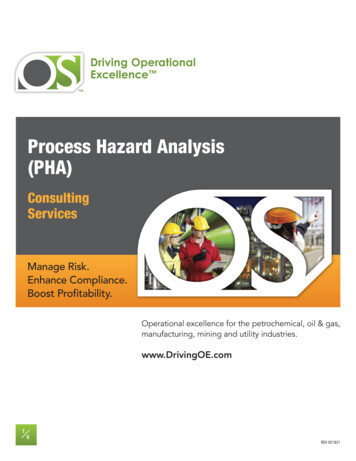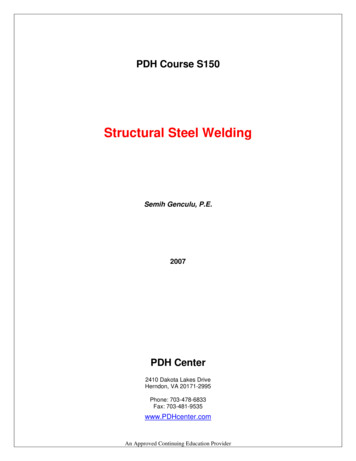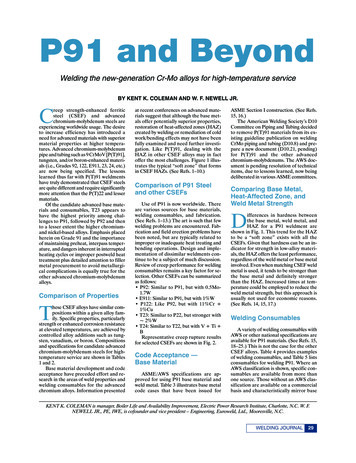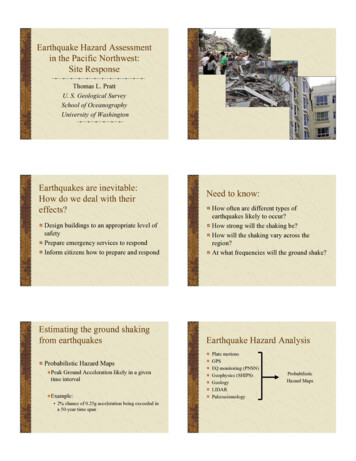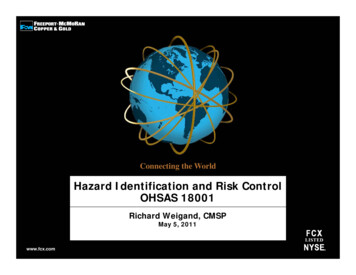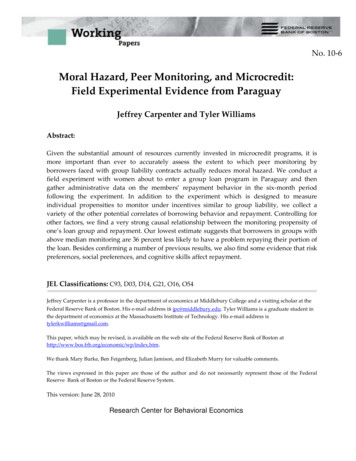
Transcription
Department:Welding ShopJob Hazard AnalysisAnalysis by:Reviewed by:Possible Hazards or TaskDescribe Harmthat could occurApproved by:HazardRating (Low/Date:Control ActionMedium/High)June, ng(PPE)Floor Jacka) Pre-operation walk-aroundinspection. Clean anyclutter surroundingmachine and check forvisible signs of wear.b) Place vehicle in park.c) Set park brake.d) Align floor jack withjacking point according tovehicle manufacturer’srecommendationse) Lever lock on floor jackshould be in uprightposition.f) Press foot lever or pumparm handle to raise vehicleg) Place jack stands inposition.a) Slip, trip or fall inmachine area.b) Vehicle may roll.c) Vehicle could dropif jack stands arenot used.d) Hand or fingerpinch/crush.e) Vehicle could dropif lever is not in thelower position.f) Other co-workerscould be crushed.Lowa) Clean/clear area/surfaces oftools/clutter etc. Use continuous goodhousekeeping practices.b) Ensure vehicle is on a level surface.c) Place wheel block behind wheels toprevent vehicle from rolling.d) Ensure the proper jack stands are used.e) Hands must be free of machine exceptlever.f) Slowly lower vehicle onto jack standsto prevent vehicle from falling.g) Be aware of others near the vehicle.Steel toedwork boots,glovesweeklyPage 1 of 34
Department:Welding ShopJob Hazard AnalysisAnalysis by:Reviewed by:Possible Hazards or TaskDescribe Harmthat could occurApproved by:HazardRating (Low/Date:Control ActionMedium/High)June, ng(PPE)Metal Sheara) Lift shear handle up (forlarge pieces, ask forassistance).b) Insert metal to be cut.(Make sure to cut only 1piece of metal at a time.)c) Gripping metal, lower theshear handle. (This willlower the cutting blade.)d) Remove cut metal.e) Lift handle and removewaste material.a) Repetitive motion(muscle strain).b) Plate metal (skinpinch), sharp metal(lacerations).c) Poorly placedhands (cutting offappendages), andsharp edges (andmetal cuts).d) Plate metal (skinpinch), sharp metal(lacerations).Higha) Take breaks every 15 minutes.b) Wear Kevlar gloves.c) Wear Kevlar gloves, place hand awayfrom blade.d) Wear Kevlar gloves.Safetyglasses, steeltoed boots,ear plugs,KevlarGlovesDailyPage 2 of 34
Department:Welding ShopJob Hazard AnalysisAnalysis by:Reviewed by:Possible Hazards or TaskDescribe Harmthat could occurApproved by:HazardRating (Low/Date:Control ActionMedium/High)June, ng(PPE)Grindera) Pre-operation walk-aroundinspection. Clean anyclutter surroundingmachine and check forvisible signs of wear.b) Examine the grinder to seethat the tool rest is set atthe required height.c) Adjust safety glass shieldabove grinding wheel.d) Turn switch to “on”position.e) Grind the work by movingthe work back and forthacross the face of thewheel.f) Turn switch to “off”position.g) Clean shavings from area.a) Slip, trip or fall inmachine area.b) Tool slippingbetween the wheeland tool rest.c) Injury from flyingparticles.d) Exceeding max.R.P.M. speed listedon grinding wheel.e) Eye injury frommetal shavings orsparks flying fromgrinding wheel.f) Bodily injury frommetal shavings(slivers orlacerations).Mediuma) Clean/clear work area/surfaces oftools/clutter etc. Use continuous goodhousekeeping practices.b) Ensure the tool rest is close enough tothe wheel to prevent the work fromslipping.c) Ensure safety glass shield on thegrinder is adjusted to permit clearvision and safety eyewear is worn.d) Wear safety eyewear(helpers/observers/other workers inareas of the machine as well), earprotection and gloves while grinder isin operation.e) Ensure no flammables are in thevicinity.f) Wear leather gloves, safety eyewear(helpers/observers/other workers inarea of the machine as well).Face shieldor age 3 of 34
Department:Welding ShopJob Hazard AnalysisAnalysis by:Reviewed by:Possible Hazards or TaskDescribe Harmthat could occurApproved by:HazardRating (Low/Date:Control ActionMedium/High)June, ng(PPE)Oxyacetylene Torch1. Turning torch ona) Wipe down work areawith damp cloth(water)b) Uncoil and straightenhoses from cylindersand ensure no kinks.c) Adjust screws onregulators so they arebacked off.d) Open cylinder valveslowly by turningcounter clockwise.e) Turn adjustment screwclockwise to desiredpressure.f) Repeat steps 3, 4, and5 for Acetylene.g) Crack open acetylenevalve on torch body.h) Use striker to ignitetorch and hold awayfrom portable unit andpersonnel.i) Adjust Acetylene torchbody valve.a) Spilling water(could cause slipand fall)b) Loose hoseaccumulation onfloor (unnoticedhose could trip andfall).c) Gas leak (couldcause fire)d) Potential gasaccumulation(torch could take awhile to light, thenlights with a ball offlame)e) Spark production(could cause burnor ignite othermaterial)f) Flame adjustment/incorrectadjustment(adjusting theHigha) Slowly apply small amount of water tocloth and wipe down work area.b) Uncoil hoses from tanks to ensure hosedoes not become a tripping hazard;examine the condition of the hoses,ensure there are no kinks or cracks.Ensure all torch valves are closed andinspect for possible leaks.c) Make sure adjustment screws onregulators are backed off so no tensionis present on adjustment screws forboth Acetylene and Oxygen.d) Turn adjustment screw clockwise todesired pressure.e) Quickly, so not to let gas accumulate,hold torch facing away from face, bodyand portable unit. Using other hand,strike flint approximately 2 inches fromtip of torch.f) Adjust Acetylene torch body valve todesired flame.g) Slowly open oxygen valve on torchbody to achieve desired flame.Gloves,Apron,Goggles orFace Shield(#5 lens)DailyPage 4 of 34
Department:Welding ShopJob Hazard AnalysisAnalysis by:Reviewed by:Possible Hazards or TaskDescribe Harmthat could occurApproved by:HazardRating (Low/Date:Control ActionMedium/High)June, ng(PPE)j)Open oxygen valve ontorch body.2. Turning Torch Offa) Close Acetylene valveon torch body.b) Close oxygen valve ontorch bodyc) Turn the acetylenevalve clockwise.d) Turn the oxygen valveclockwisee) Close adjustmentscrews on regulatorf) Close adjustmentscrews on regulator forOxygeng) Slowly openAcetylene valve on thetorch body to bleedlines.h) Slowly open Oxygenvalve on the torchbody to bleed lines.i) Close Acetylene valveon torch bodyj) Close Oxygen valveon torch bodyflame incorrectlyproducingundesiredmagnitude)g) Gas (potentialinhalations,explosion)h) Gas (potentialexplosion)i) Valve and Stem(pinch points)h) Position fingers on acetylene valveensuring they do not come in correctwith the valve stem. Turn valveclockwise.i) Position torch nozzle away frompersonnel and any heat source. Openvalve on torch body.j) Position fingers on acetylene valve ontorch body ensuring they do not comein contact with the valve stem. Turnvalve clockwise.k) Position fingers on oxygen valve ontorch body ensuring they do not comein contact with the vale stem. Turnvalve clockwise.Page 5 of 34
Department:Welding ShopJob Hazard AnalysisAnalysis by:Reviewed by:Possible Hazards or TaskDescribe Harmthat could occurApproved by:HazardRating (Low/Date:Control ActionMedium/High)June, ng(PPE)Metal-inert gas (MIG) welding1. Weldinga) Clean off object to bewelded.b) Spray weld primeronto anything to bewelded (zinc spray)c) Open gas untilpressure is 25 psi onflow meter.d) Hook grounding clampon object near weldingarea.e) Plug in weldingmachine.f) Put on welding mask.g) Conduct several testwelds on scrap metalto achieve the properwire feed speed.h) Touch wire to metalwhile moving in asmooth motion.Constantly holdingdown the torch trigger.i) Adjust the wire feedspeed until desiredweld is achieved.a) Sharp edges(lacerations tohands or body).b) Zinc fumes(inhalation offumes)c) Frayed wire(electrical shock)d) Visor of a wronggrade design forthe type of weldingbeing conducted(ultra-violet light(radiation burns,eye damage)e) Welding fumes(lung cancer)f) Fireg) Hot surface, sparks(burns to hands orbody).Mediuma) Wear leather gloves.b) Only use zinc spray in a well ventilatedarea, always spray away from face.c) Keep fingers and hands firmly onhandle of clamp away from object andteeth of the clampd) Check over electrical wire for any worninsulation.e) Check with manufacturer instructionmanual for the types of jobs the visor isdesigned for.f) Wear leather gloves.g) Wear proper visor of a grade designedfor the type of welding you areconducting.h) Weld only in well ventilated areas.i) Have a fire extinguisher on site at alltime.j) Wear goggles, coveralls, leather gloves.Gloves,Leatherjacket,weldinghelmet, Steeltoed boots,Ear plugsDailyPage 6 of 34
Department:Welding ShopJob Hazard AnalysisAnalysis by:Reviewed by:Possible Hazards or TaskDescribe Harmthat could occurApproved by:HazardRating (Low/Medium/High)Date:Control ActionJune, ng(PPE)j)Weld actual metalpiece.k) Chip away any slagwith hammer.2. Shutting off the machine.a) Turn off gas.b) Pull trigger to get outall excessive gas.c) Turn off machine.d) Unplug and returnwelding machine tostorage.e) Slowly openAcetylene valve on thetorch body to bleedlines.f) Slowly open Oxygenvalve on the torchbody to bleed lines.g) Close Acetylene valveon torch body.h) Ultraviolet light(Radiation burns,eye damage)i) Welding fumes(lung cancer), fire.j) Hot surface, sparks(burns to hands orbody). Ultravioletlight (Radiationburns, eye damage)k) Flying slag chips(eye injury, burnsfrom hot slag).Page 7 of 34
Department:Welding ShopJob Hazard AnalysisAnalysis by:Reviewed by:Possible Hazards or TaskDescribe Harmthat could occurApproved by:HazardRating (Low/Date:Control ActionMedium/High)June, ng(PPE)Hydraulic PressProper Use:The hydraulic press is of asimple double acting hydraulicactuator design employinghydraulic force to get the workdone. The most importantthing to keep in mind whenusing this piece of equipmentis to ascertain that the piecebeing worked on is properlyblocked. If not, it is verypossible that the piece willcrack or break under the loador slip out and cause injury tothe operator. Remember theload capacity is 50 tons, that’sa lot of force.Crush injuryHigha) Ensure a clean work area.b) Block up/support the piece beingworked on in such a manner as to avoiddamaging the piece or having it get“spit out” from the pressure applied.c) Use the appropriate personal safetyequipment for the task. (protectiveeyewear, footwear)d) Make sure all safety guards and coversare in place.e) Clear the area of people before starting.f) Align the working piece with thecylinder before using.g) Maintain slack in the winch cable afteradjusting the table height, and makesure all the table pins are in positionand secure.h) Lock the cylinder carriage beforeusing.i) Do not exert excessive force whenusing the press, if it feels like it’s goingto break it probably will.Safetyglasses orFace shield,gloves,Safety bootsDailyPage 8 of 34
Department:Welding ShopJob Hazard AnalysisAnalysis by:Reviewed by:Possible Hazards or TaskDescribe Harmthat could occurApproved by:HazardRating (Low/Date:Control ActionMedium/High)June, ng(PPE)j) Never adjust the relief valve setting onthe hydraulic system.k) Before starting the machine make surethe hydraulic lines are in goodcondition, high pressure hydraulic leakscan easily sever the skin.l) Clean the area of debris after use with abrush. (not bare hands)Page 9 of 34
Department:Welding ShopJob Hazard AnalysisAnalysis by:Reviewed by:Possible Hazards or TaskDescribe Harmthat could occurApproved by:HazardRating (Low/Date:Control ActionMedium/High)June, ng(PPE)Drill PressProper Use:The drill press is commonlyused in conjunction with a drillpress vice positioned on thetable to securely hold the workbeing drilled, and protect theoperator from injury. The useof various types of clampingdevices may also be employedwhen the piece being drilled istoo large for the vice. In anyevent ascertain that the piecebeing drilled is securely heldin position.The speed selection is alsoimportant and dependent onthe style or size of drill bitbeing used and the type andthickness of the material beingdrilled. Generally largerdiameter bits are turnedslower, and harder materialsalso require a slower rotationalspeed.Lacerations, hot metalfilings hitting you, itembeing drilled twists inyour hand, item falls onyour feetMediuma) Ensure a clean work area.b) Remove jewellery or tie back long hairthat may be caught by the machine(rings, necklace).c) Use the appropriate bit or cutter for thematerial being drilled.d) Ascertain the correct rotational speedfor the material being cut.e) Secure the material to the drill presstable via the vice or use of clamps.f) Remove the chuck key from chuck andsecure table friction lock before startingthe machine.g) Use the appropriate personal safetyequipment for the task (protectiveeyewear, footwear)h) Make sure all safety guards and coversare in place.i) A dust mask may be required forcertain types of materials. (consultMSDS sheets)Safetyglasses,Gloves,Footwear,Dust maskDailyVarious types of cutting fluidsPage 10 of 34
Department:Welding ShopJob Hazard AnalysisAnalysis by:Reviewed by:Possible Hazards or TaskDescribe Harmthat could occurApproved by:HazardRating (Low/Date:Control ActionMedium/High)June, ng(PPE)may also require slowerrotational speed.Various types of cutting fluidsmay also be employed in orderto prevent heat build-up. Askyour instructors for moredetails.j) Do not exert excessive force whendrilling; let the bit do the workk) Be aware of heat build-up from thecutting operation.l) Use
Welding Shop Date:, 2019 Possible Hazards or Task Describe Harm that could occur Hazard Rating (Low/ Medium/High) Control Action Personal Protective Equipment (PPE) Frequency of Monitoring Floor Jack Page 1 of 34 a) Pre-operation walk-around inspection. Clean any clutter surrounding machine and check for visible signs of wear. b) Place vehicle in park. c) Set park brake. d) Align floor jack .



